
|
![]()
Greatest Films of the 1920s
1920 | 1921 | 1922 | 1923 | 1924 | 1925 | 1926 | 1927 | 1928 | 1929
Title Screen Film Genre(s), Title, Year, (Country), Length, Director, Description 

The Great White Silence (1924, UK), 107 minutes, D: Herbert G. Ponting
The official film record of Captain Robert F. Scott's ill-fated, legendary trip to the South Pole, actually filmed from 1910 to 1912 by cinematographer Herbert Ponting. Almost every aspect of the expedition was included: the scientific work, life in camp and the local wildlife including the characterful Adélie penguins. Most importantly, Ponting recorded the challenges faced by the expedition in preparing for the journey. Ponting was unable to record the final stages of Scott’s journey: his final last trek to the Pole with three other men from the party and their subsequent death. Another film chronicling the trip was Ealing Studio's Technicolor feature Scott of the Antarctic (1948, UK).
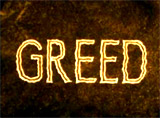



Greed (1924), 109-150 minutes, D: Erich von Stroheim
Originally at 10 hours, but severely edited down, one of the masterpieces of the silent era. It was the story of a husband McTeague (Gibson Gowland) and wife Trina (Zasu Pitts) who became consumed by greed and an obsession with money. She won $5,000 in the lottery and soon the couple were changed from devoted lovers into adversaries, especially after his San Francisco dentistry practice failed. Their avarice-based hatred consumed them, and in the classic finale filmed in Death Valley, McTeague murdered his best friend Marcus (Jean Hersholt).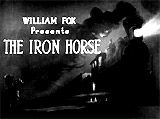



The Iron Horse (1924), 119 minutes, D: John Ford
This was Fox Film's silent western epic-scale response to The Covered Wagon (1923) - the story of the building of the transcontinental railroad, a railroad linking East and West. Noted as the film to establish John Ford's reputation as one of Hollywood's most accomplished directors. The slowly-paced film was a combination of a fictitious narrative, interwoven with historical background. It told the story of an Illinois man, hero Dave Brandon (George O'Brien), searching for the shortest route over a mountain range to unite the Union Pacific (starting from Omaha, Nebraska) and Central Pacific (starting from Sacramento, California) - two railroads at Promontory Point, Utah in 1869. Noted for realistic scenes of a cattle drive, an Indian attack, a saloon brawl, and the Pony Express, and appearances of historical figures including Wild Bill Hickok (Jack Padjan), Buffalo Bill (George Waggner), and Abraham Lincoln (Charles Edward Bull). The most memorable moment was the driving of the final railroad spike.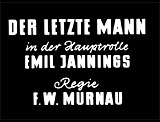


The Last Laugh (1924, Germ.) (aka Der Letzte Mann), 77 minutes, D: F.W. Murnau
Murnau's notable silent film weepie classic told its entire story about a proud, elderly but demoted Atlantic Hotel doorman or Hotelportier (Emil Jannings) in Berlin through visualization, innovative camera movements (with only one inter-title), stylized mis-en-scene, a subjective point-of-view, and optical effects. The doorman was relieved of his position and his all-important uniform, and was re-assigned to a less strenuous, purely menial position as a washroom attendant. Stunned, scorned and humiliated, he was forced to reveal his lowly position to his aunt and neighbors. Pioneering and celebrated German cameraman Karl Freund provided the cinematography - revolutionary camera work that virtually invented a host of new techniques for a mobile camera ("unchained camera"). An unexpected, unrealistic happy ending was tacked on by the studio.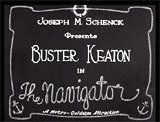


The Navigator (1924), 60 minutes, D: Donald Crisp and Buster Keaton
The comic story of two spoiled young people Rollo Treadway (Buster Keaton) and the Girl (Kathryn McGuire), who were left stranded on his father's drifting and deserted ocean liner. At first, they were not aware of each other's presence, and then were ignorant of taking care of themselves to avoid starvation, in a number of hilarious gags. They fell in love. Memorable moments include the routing of a climactic cannibal attack.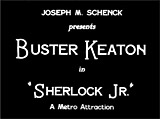




Sherlock Jr. (1924), 44 minutes, D: Buster Keaton
Stone-faced director/producer Buster Keaton starred as a lovelorn film projectionist named Sherlock Jr. who wanted to be a detective, in this marvelously inventive, short silent film comic fantasy. After he was wrongly accused (framed) of stealing the watch of his girlfriend's (Kathryn McGuire) father, he fell asleep in the theater. He dreamt that he entered the film's screen and joined the action of the characters. He became a master detective Sherlock Jr., and solved the crime of thievery, determining that his rival actually stole the watch. In the final boy-gets-girl sequence in the projection booth, the flustered 'detective' followed the cues of the leading-man actor on screen and kissed his girlfriend.


The Thief of Bagdad (1924), 155 minutes, D. Raoul Walsh
Raoul Walsh's timeless and expensive silent costume fantasy was a lavish and bold Arabian Nights adventure - and a spectacular accomplishment in production design and state-of-the-art special effects from production/art director William Cameron Menzies. It was inspired by writer/director Fritz Lang's Der Müde Tod (1921) (aka Destiny or The Tired Death) - the source for the flying horse and carpet sequences. The title character, the mischievous Thief of Bagdad (Douglas Fairbanks, Sr., credited as Elton Thomas), stole a magic rope used to scale walls and rob people, including the royal family. In the palace of the Caliph (Brandon Hurst), he disguised himself as regal Prince Ahmed to win the heart of an exotic, ravishingly-beautiful Princess (Julanne Johnston), who had to choose a princely husband on her birthday. Flogged for his deceptive fraud, Ahmed repented, reformed and confessed the truth to a Holy Man (Charles Belcher). A test or challenge was devised by the Princess (who had already been smitten by Ahmed) -- the suitor who retrieved the rarest treasures within the mysterious Orient after seven moons would win her hand. The storybook film featured amazingly difficult stunt work performed by Fairbanks, such as a ride high above the city on a magic carpet, a battle with a fire-breathing dragon in Caverns of flame, and a ride on the back of a flying horse (or Pegasus). He had to also battle the evil and treacherous Mongol Prince (So-Jin) upon his return to woo back the Princess and prove his love.